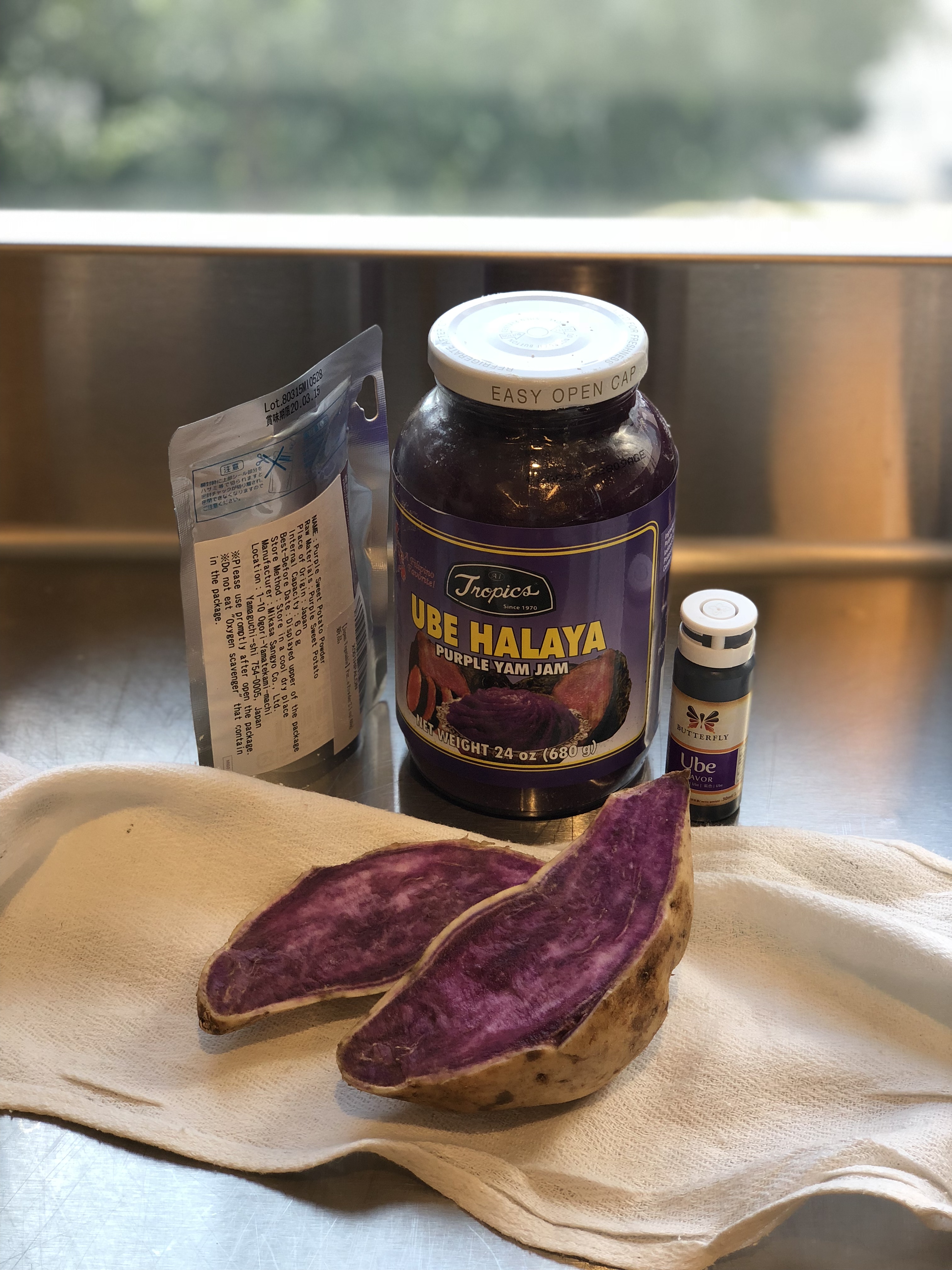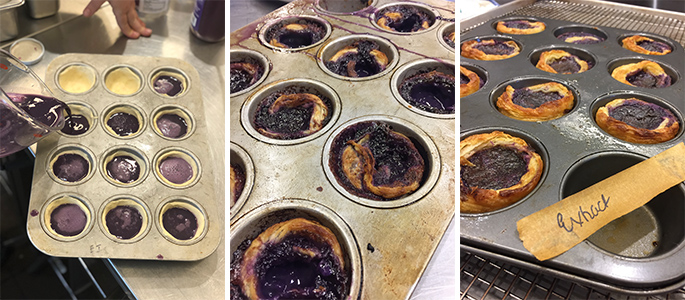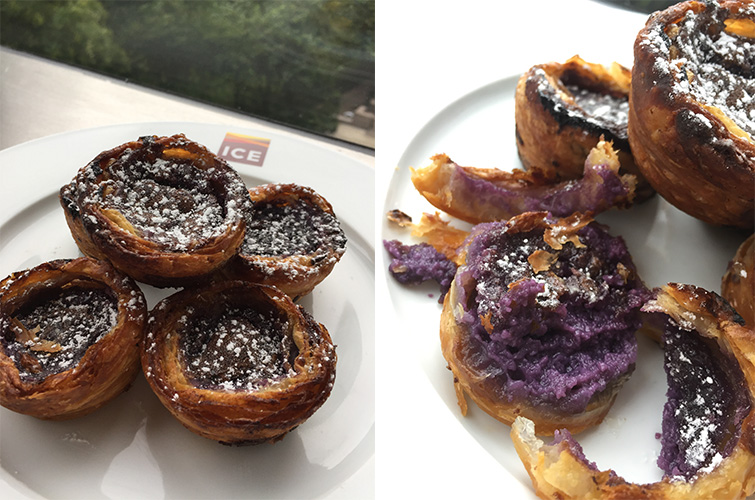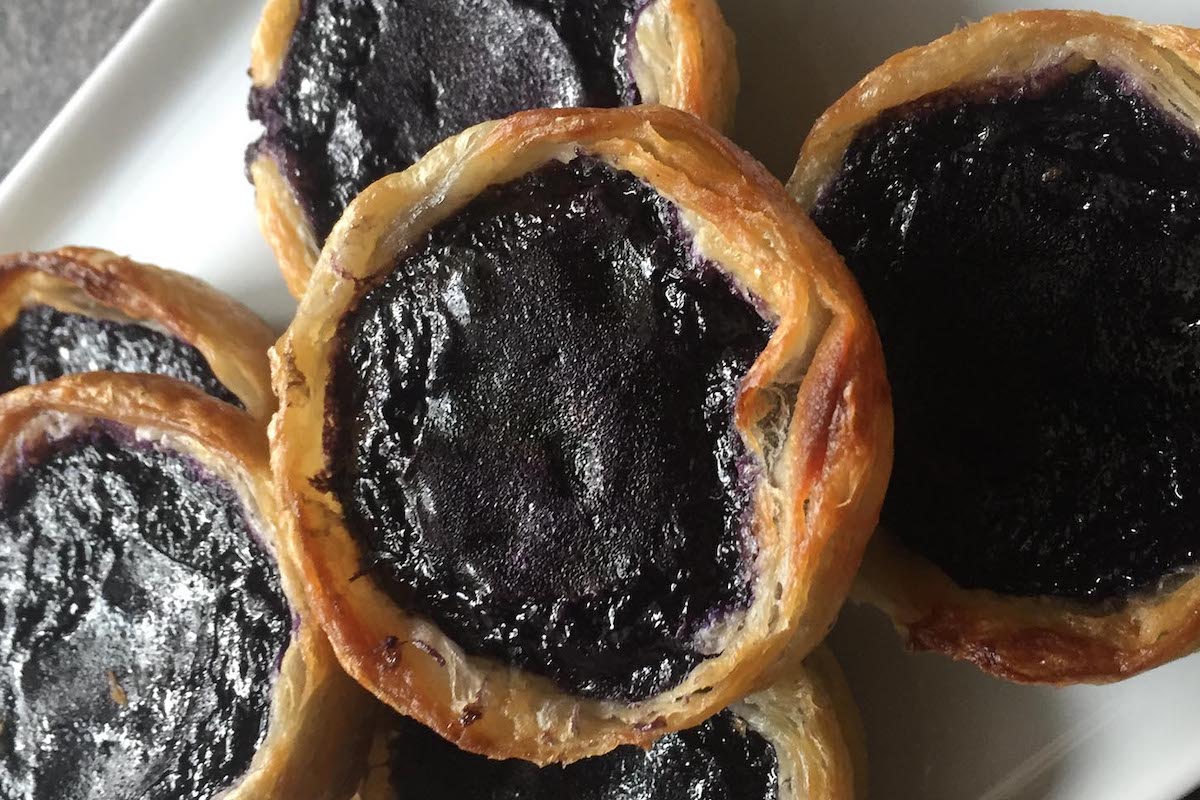As I write, I’m part way through my fifth go at Portuguese custard tarts or pasteis de nata. This is what happens to chefs. We get something in our minds and we can’t let go. Now I’m immersed and I’m not giving up until I win. And by win, I mean, feel proud enough of the product that I can share it with you.
This exploit began as I pondered current trends in pastry. As a chef and business owner, it’s important to keep up with what is happening in the pastry world. Some believe the secret to success is riding trends, but I believe it’s keeping one step ahead and innovating as much as possible.
Recently I started to notice gorgeous purple dessert treats creeping along my Instagram feed: ice cream, cupcakes, doughnuts and cakes. Funnily, I hate purple food coloring. Students always want to use it, but it always lets them down. It’s never truly purple but rather tones of blue or gray, or something else completely. It gets muddy when you try to mix your own shade and it famously fades. Once, after covering three tiers of cake in purple in The Art of Cake Decorating course at the Institute of Culinary Education, a pastry student came back the next day to find each of them a different shade of blue. While it may be the color of kings, purple is not the color of food artists. So when I saw these gorgeous shades of purple, I was even more impressed by the natural method causing the color: using ube.
Ube is a purple yam native to Asia and the Philippines. The fresh tuber has a gorgeous deep tone of a pinkish purple, which changes as heat and moisture are applied. The flavor of ube is quite unexpected. It’s much sweeter than your average sweet potato and has a super nutty aroma that took me by surprise when I first encountered it. And it’s full of fiber and vitamin A, so it’s good for you. A staple in the Philippines, it’s very hard to find in the U.S., fresh or in season.
Forms of ube that can be easily found online are powdered, jam and extract. The powder has a gorgeous lavender color, while the extract is a super dark, vivid purple. The jam is made from the fresh yam but has sugar added and a somewhat grainy and gummy texture. While some may love it spread on toast, the ube jam isn’t the right choice for a recipe where ube is the star.
I procured the extract and the powder, and for good measure, I wanted to throw in something fresh so I included the Okinawan sweet potato in the mix. Not true ube, this is the one fresh purple sweet potato that can be found easily in New York City grocery stores.

Penny experiments with ube powder, jam and extract, plus an Okinawan sweet potato. (Photo courtesy of the Institute of Culinary Education)
There were so many things I wanted to make with ube, but finally, I limited myself to whoopie pies and a version of the Portuguese egg tarts, which are trending. I’ve been hearing about the tarts for a while now, but of late they have been flooding my consciousness. Look up #pasteisdenata on Instagram and you’ll see what I mean.
Full disclosure, I have never had these tarts from the source. And by source, I mean Fabrica de Pasteis de Belem in Lisbon, where the pastries originated and where their secrets are kept under lock and key. The recipe is a trade secret of the Lisbon bakery, and while a couple of tips have slipped out, the bakery is so protective about it, the makers may lean on exaggerations to keep anyone from figuring out their methods. I like a challenge.
My attempts at making these began with David Leite’s recipe on Leite’s Culinaria. He had gone to the source, tried his best and didn’t get as far as he would have liked. My goals were reasonable: I just wanted a yummy, blistering custard tart that I could use as a vehicle for the aromatic, sweet and nutty ube.
Several of the instructions on Leite’s Culinaria struck me as unusual. It was a laminated dough but with soft, mushy butter. The dough was rolled into a spiral and pressed into pans. It was a super thin custard with milk, egg yolks and a cooked sugar syrup, and it was baked at 500-550 F! I could understand a version of puff pastry being cooked that high, but no baked custard I’d ever seen has been cooked at that temperature. I worried that the custard would be set but the pastry not cooked, and that is exactly what happened the first time around. The butter seeped out so much that it covered the bottom of the oven. For the next try, I chilled the formed dough before filling and baking, and put the convection on high fan. This helped. The tarts were edible, if not a bit sweet for me.
For the next try, I thought: If it’s a laminated dough, why not just use quick puff pastry? Many of the second-tier versions of this recipe called for pre-made puff pastry. Then I focused on the ube custard: one with the jam and one with a combination of powder and extract, and tried them using freshly made quick puff. Disaster number two: The quick puff was so puffy that it pushed the custard up and out of the dough cups and underneath, making a sticky mess, while it stubbornly refused to fully cook at the base. I tried to use some of the ube powder to replace the flour in the custard recipe, and this version of the custard never set. And forget the ones in the middle of the muffin pan, they barely baked at all.

Chef Penny shares her repeated attempts at the recipe. (Photo courtesy of the Institute of Culinary Education)
With the next go around, I left behind the idea of using the jam or fresh sweet potato. They created a custard with a less-refined mouthfeel and instead, I settled on using a combination of the powder and the extract. I stubbornly stuck with the puff pastry one more time, I had some left after all. It was delicious and crispy but too thick for the tender custard.
For the next attempt, I went back to the soft butter version of the pastry. I heard rumors of lard being used in the dough, either a little or all, and wanted to see if that made it better. I swapped 10 percent of the butter for lard and beat them together. The lard left me with a dough that was super crisp but felt greasy and had an almost chewy texture, so no on the lard.
Instead of rushing it, I learned to let the dough sit overnight in the refrigerator, an absolute must. I perfected the finger motions of filling the cups. The custard was delicious, not too sweet and just a bit savory, the only thing left to perfect was the bake. A new cupcake tin, baked this time for nine minutes at 500 F with low fan convection. They looked perfect from the top, but still the bottoms were soft and saturated. I wondered if in Lisbon, they baked them directly on a deck oven, so I tried a heated pizza stone. Under-baked bottoms persisted.
And then it occurred to me: the original ones are made in small tin pans. In my variety of tests, I had used different types of cupcake pans: dark bottom, thicker, thinner. This had a direct effect on how the pastry baked, so using thin individual pans, baked on a hot sheet tray or heated pizza stone is the way to go. Does this mean you have to buy more tools to use only one time? No. Use smaller muffin tins with less dough and only use the outside cavities, avoiding the centers where there is too much insulation to cook evenly.
With no struggle at all during the waiting periods, I made delicious, beautiful ube whoopie pies with a chai cream filling. A good snack for the fight! And now, when I want to make edible items a beautiful purple, I know where to turn. Ube is truly a stunning, versatile product to make your baked goods shine. Here’s a recipe for experimenting with it.
***

Chef Penny’s final ube custard tarts come out beautifully. (Photo courtesy of the Institute of Culinary Education)
Recipe: Chef Penny’s Ube Custard Tarts
Inspired by David Leite’s recipe for Portuguese custard tarts.
Ingredients:
- 227 grams all-purpose flour
- 2 grams salt
- 155 grams cold water
- 227 grams unsalted butter, softened
- 80 grams milk
- 27 grams all-purpose flour
- 10 grams ube powder
- 220 grams milk
- 3 grams salt
- 220 grams granulated sugar
- 142 grams water
- 1 cinnamon stick
- Zest of a lemon left large
- 120 grams egg yolks
- 15 grams ube extract
Directions:
To make the dough:
- Soften the butter completely until it’s spreadable.
- Mix the flour, salt and cold water together, just until combined. Don’t overwork or the dough will become tough.
- Let the dough sit covered at room temperature for 20 minutes.
- Roll the dough into a very thin, rectangular sheet. The dough should be less than 1/8″. Dollop 1/3 of the butter over 2/3 of the right side of the rectangle. Spread this with a small offset spatula to thinly cover 2/3 of the dough.
- Fold the left part with no butter over the center and fold again to the right like a letter. Turn this so that the fold is facing you. Using enough bench flour to make sure the dough doesn’t stick, roll again into a large rectangle, about 1/8″ thick. Repeat butter and folding procedure.
- Turn again so the folded side is towards you. Roll again to the rectangle. This time dollop the final third of the butter all over and spread thinly over the entire surface of the dough.
- As securely as possible, roll the dough into a cylinder starting from the long end in front of you. Try to do this as tightly as possible, especially the very first part that will make up the center of the cylinder. Wrap the cylinder in plastic wrap and refrigerate for at least six hours or overnight. You can also freeze the dough at this point.
- When the dough has rested and chilled, cut rounds from the log. If using regular muffin tins, the rounds should be about 3/4″ thick. If using smaller ones, about half that size.
- Spray the pans you’re using with release spray. Place a disk of the chilled dough into each cup and let this sit for about 15 minutes until it’s soft enough to spread. Dip your thumb in water and in a circular motion, start spreading the dough along the bottom of the cup. When it’s reached the edges, begin to spread it up the sides of the cup, working to avoid any gaps that could let your filling seep out. The bottom should be slightly thicker than the sides.
- Refrigerate this while you prepare the custard.
For the custard:
- Mix the flour, ube powder and salt together. Add half of your milk to the powder to make a paste. Incorporate the ube and vanilla extracts and set aside.
- In a small saucepan, combine the sugar, water, cinnamon stick and lemon zest. Cook until this mixture reaches 220F.
- In another small saucepan, scald the milk. Mix the hot milk into the cold mixture. When the sugar reaches 220F, remove the cinnamon stick and lemon zest and stir that in as well. Temper in the egg yolks.
- This custard can be set refrigerated and used later, or cooled and used right away.
To complete the tarts:
- Fill each cavity about 3/4 full. Do not over fill or it will spill over and stick your tarts to the pan. Place into an oven that’s preheated with a pizza stone, if one is available, to 500F or as hot as it goes. Place the pan with the tarts on the stone and bake for 9-12 minutes, until the sides of the dough look brown and crispy and the custard is set and has some browning. This will be harder to see with the ube as it’s a dark purple.
- Cool and serve as soon as they are cool enough. They are best eaten soon after coming from the oven.
By Chef Penny Stankiewicz, Institute of Culinary Education


